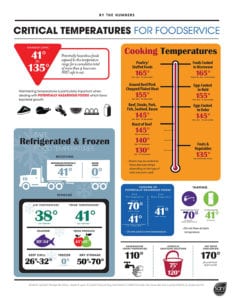Critical Temperatures for Foodservice
Maintaining temperatures is particularly important when dealing with potentially hazardous foods which favor bacterial growth
Temperature plays a critical role in food safety. From receiving to preparation and serving, food temperature must be monitored closely to prevent the spread of foodborne illness.
Proper cooking is fundamental to eliminating harmful pathogens that may be present in food. To achieve this, different types of foods must be heated to unique temperatures, sometimes for different lengths of time. Our downloadable foodservice temperature guide provides proper cooking temperatures for a variety of meats, poultry, and other foods.
- A food thermometer or probe should always be used to ensure proper internal temperature has been reached prior to serving.1
- To prevent the threat of cross-contamination, thermometers and probes must be sanitized prior to and after each use.
Because bacteria multiply rapidly at room temperature, storing and holding foods at proper temperatures is also essential. A “Danger Zone” exists between 40°F and 140°F.
- Potentially hazardous foods (e.g., meats, poultry, seafood, cut fruit, eggs and milk) exposed to this temperature range for a cumulative total of more than 4 hours are not safe to eat.1
- Perishable foods should never be left out for more than 2 hours (1 hour if temperature is hotter than 90°F).2
- In foodservice settings like buffets, it is important to monitor food temperatures when product is placed in steam table or hot holding units and checked at least every 2 hours thereafter.3
Download our helpful resource on proper temperature controls that should be practiced in foodservice every day.


